There are two main ways to handle your money: DeFi vs CeFi. Decentralized finance is a modern way of managing money that operates on decentralized networks, utilizing smart contracts and blockchain technology to eliminate intermediaries (banks and other institutions).
A centralized financial system is the traditional way of banking in which people trust a bank or third-party institution to handle their money.
In this brief, you will receive the answers to the questions: What is Cefi? How does DeFi work? This article will explore the key features of CeFi vs DeFi and what the future might hold for both of these approaches.
What is сentralized finance (CeFi)?
So, what is CeFi? It is a financial system in which governmental bodies, banks, investment firms, and similar entities have centralized authority over financial transactions and money circulation. This framework encompasses all traditional financial services.
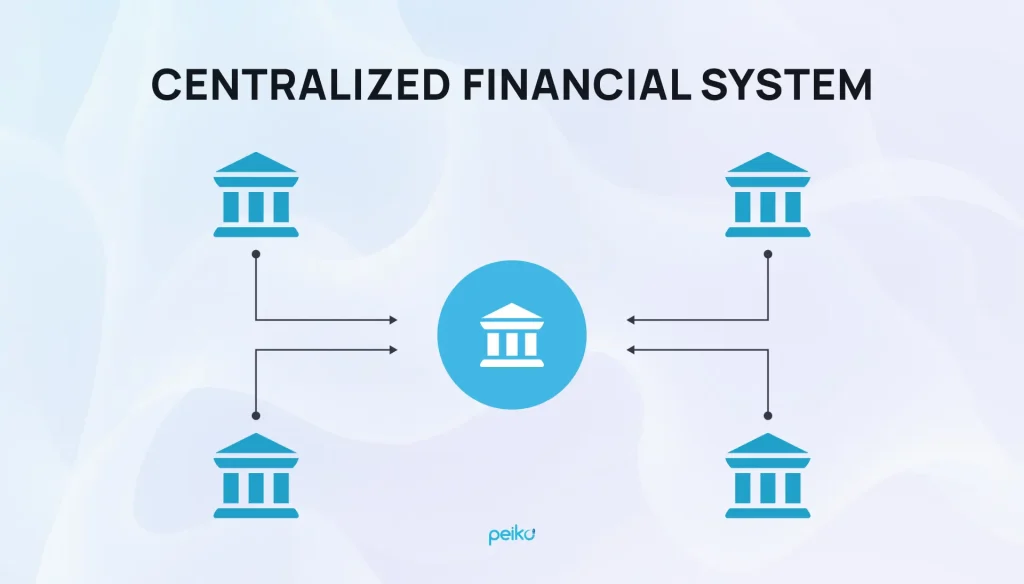
The CeFi meaning implies financial transactions are conducted exclusively through centralized regulatory bodies and operate within the established regulatory framework.
What is decentralized finance (DeFi)?
Whats DeFi? Unlike traditional banking and centralized financial services, decentralized finance operates without a central authority, leveraging blockchain platforms and smart contracts.
DeFi platforms enable individuals to access loans, make payments for goods and services, and engage in margin trading directly, bypassing intermediaries such as banks, insurance companies, or governmental oversight. This decentralized approach aims to increase financial inclusion and transparency by utilizing blockchain technology to automate and secure transactions peer-to-peer (P2P).
At Peiko, we know how to build robust DeFi solutions, including P2P crypto exchange development services and more.
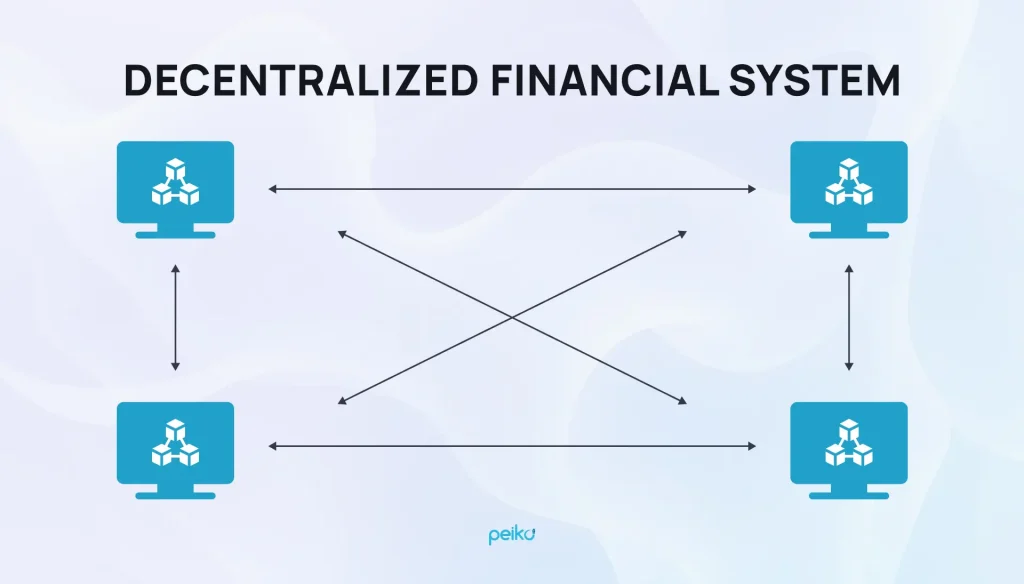
Blockchain operates as a digital ledger that records transactions in a chronological and immutable manner. Each transaction or piece of data, known as a “block,” is linked to the previous one using cryptographic techniques, forming a continuous chain of blocks — hence the term “blockchain.” Once recorded, data on the blockchain cannot be altered retroactively without consensus from the network participants, ensuring the ledger’s integrity.
All transactions on the blockchain are visible to participants, enhancing transparency and accountability. The network is not controlled by a central authority or intermediary; instead, transactions are validated and recorded by nodes participating in the network.
Beyond cryptocurrencies, blockchain has broad applications across industries such as finance, gaming (GameFi), supply chain management, healthcare, and more. Blockchain enables efficient and secure digital interactions across various industries.
By the way, did you hear about what is DeSci? This term means the combination of decentralized finance and science.
The comparison of CeFi vs Defi
The table below illustrates the distinguishes between CeFi vs DeFi, and how they differ in governance, accessibility, transparency, security, regulatory compliance, and user control.
| Aspect | Decentralized finance (DeFi) | Centralized finance (CeFi) |
|---|---|---|
| Control | Operates autonomously through smart contracts on blockchain networks governed by decentralized protocols | Controlled by centralized entities such as banks, brokerage firms, and financial institutions |
| Intermediaries | Minimizes reliance on intermediaries; transactions are peer-to-peer or automated by smart contracts | Relies heavily on intermediaries like financial institutions or other third parties to facilitate transactions |
| Accessibility | Usually more accessible globally | Access can be restricted based on regulatory compliance and geographic location |
| Transparency | High transparency due to public blockchain records and smart contract execution visible to all participants | Transparency levels vary; they may be lower due to centralized control over information |
| Censorship resistance | Highly resistant to censorship; transactions are immutable once recorded on the blockchain | Vulnerable to censorship as transactions can be controlled or blocked by centralized authorities |
| Security | Relies on blockchain technology and cryptography; vulnerabilities can arise from smart contract bugs or network attacks | Provides security measures through centralized systems but may be vulnerable to hacks or breaches |
| Innovation speed | Enables rapid innovation and experimentation due to decentralized governance and open-source nature | Innovation may be slower due to regulatory constraints and institutional decision-making processes |
| Compliance and regulation | Compliance is enforced through decentralized protocols and automated governance mechanisms | Adheres strictly to regulatory standards imposed by governing bodies and financial authorities |
| User control and ownership | Users control their financial activities and assets through self-custody wallets and decentralized applications (dApps) | Control and ownership are entrusted to centralized entities, with users relying on their services |
| Costs and fees | Typically, lower transaction costs and fees are due to reduced intermediaries and automated processes | Higher transaction costs and fees due to intermediary services and operational overheads |
Features of CeFi
The centralized financial system offers a familiar and structured environment for individuals and businesses to manage their money. Let’s explore the key characteristics that have established CeFi as a trusted finance ecosystem.
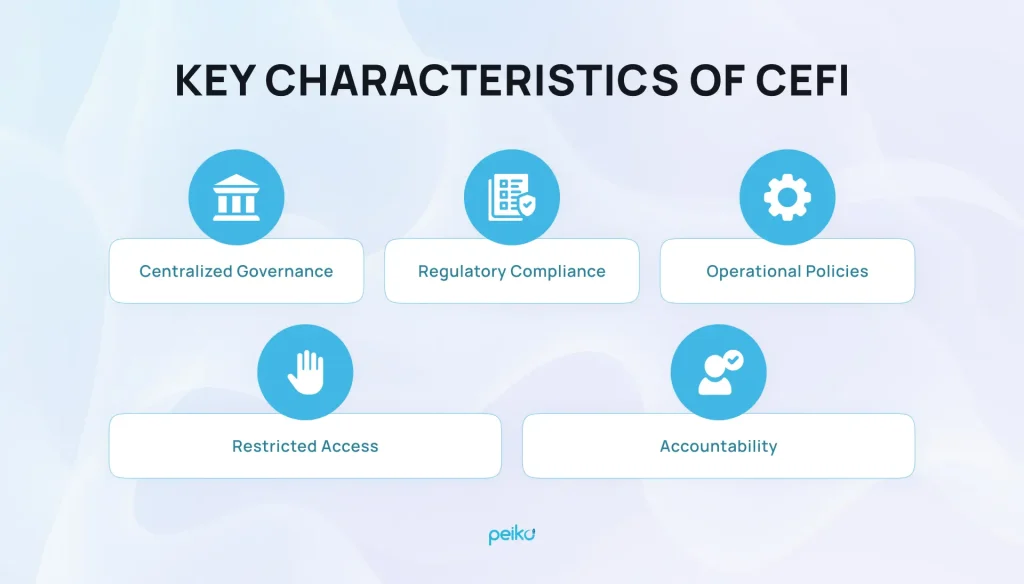
Centralized governance
Comparing CeFi DeFi services, CeFi ones are characterized by a centralized authority that oversees and regulates financial activities within local and global markets.
Regulatory compliance
Centralized financial institutions adhere to stringent government regulations to ensure financial stability, user data protection, and compliance with KYC (know-your-customer) and anti-money laundering policies.
Operational policies
Most traditional financial entities implement policies designed to safeguard customers’ interests and provide control of clients’ funds control. But sometimes, the same control method can lead to bureaucratic delays and corruption.
Restricted access
Often, access to CeFi services and opportunities is limited and contingent upon factors such as creditworthiness and geographic location.
Accountability
CeFi institutions are accountable to regulators and the public, disclosing financial performance and operational details to ensure transparency.
Examples of CeFi
These CeFi examples can be found across various sectors, each demonstrating centralized control and management within their respective domains:
Traditional banking institutions
- JPMorgan Chase: As one of the largest banks in the United States, JPMorgan Chase exemplifies CeFi by centrally managing monetary flows and offering comprehensive financial services. These include traditional banking services such as loans, mortgages, and online banking facilities.
- Bank of America: Another prominent example, Bank of America operates under a centralized model to provide a wide range of financial services, encompassing personal banking, business banking, wealth management, and investment advisory services.
Investment firms
- Fidelity Investments: Renowned for managing investments, Fidelity Investments offers CeFi services such as mutual funds, retirement planning, brokerage services, and financial advisory to individual investors and institutional clients alike.
- Vanguard: It is a leading investment management company operating within a centralized framework. It provides investment products, retirement planning solutions, and advisory services.
Stock exchanges
- NYSE (New York Stock Exchange): As one of the largest stock exchanges globally, NYSE facilitates centralized trading of stocks and securities. It sets trading rules, maintains market order, and offers a platform for enterprises to list their shares.
- NASDAQ: Another major player in stock exchanges, NASDAQ operates with centralized oversight. It offers trading opportunities for stocks, options, and ETFs while ensuring regulatory compliance.
Insurance companies
- Allstate: A prominent insurance provider in the U.S., Allstate operates within CeFi by offering diverse insurance products such as auto, home, life insurance, and retirement solutions, all managed centrally to ensure regulatory compliance and risk management.
- Prudential: This insurance CeFi platform provides a range of insurance and financial products, including life insurance, annuities, mutual funds, and retirement planning services. These are all managed centrally to meet regulatory standards and ensure customer protection.
Centralized crypto exchanges
- Binance, Coinbase: The centralized crypto exchanges are also related to CeFi because they have a unified regulatory company that owns an exchange.
We are here to help

Drawbacks of the CeFi ecosystem
While a centralized financial system offers a sense of security and reliability, it also presents significant drawbacks:
- Vulnerability: The CeFi meaning implies relying heavily on centralized institutions like banks and governments, making the system susceptible to failures, fraud, or security breaches targeted at these single control points.
- High costs: Centralized financial operations tend to be costly due to fees, regulatory compliance costs, and expenses associated with intermediaries, which can add up and increase the overall cost of financial services.
- Limited transparency: CeFi may lack sufficient transparency in many cases. For instance, banks might not fully disclose loan details, and investment firms may withhold information about their strategies or fund performance, limiting stakeholders’ visibility.
- Limited customization: Centralized financial services are often standardized and distributed through centralized channels, which can restrict customization to effectively meet individual customer needs.
- Low efficiency: CeFi systems can be slow and inefficient due to the bureaucratic processes, regulatory requirements, and compliance burdens imposed on centralized institutions.
- Lack of control and autonomy: Individuals and institutions using CeFi have limited control over their financial transactions and assets. They must rely on centralized institutions for financial decisions, reducing autonomy in managing their finances.
Features of DeFi
Whats DeFi peculiarities? Comparing CeFi vs DeFi, DeFi operates on a set of unique principles that unlock new possibilities for financial inclusion, transparency, and innovation. Let’s consider the key characteristics and benefits of DeFi.
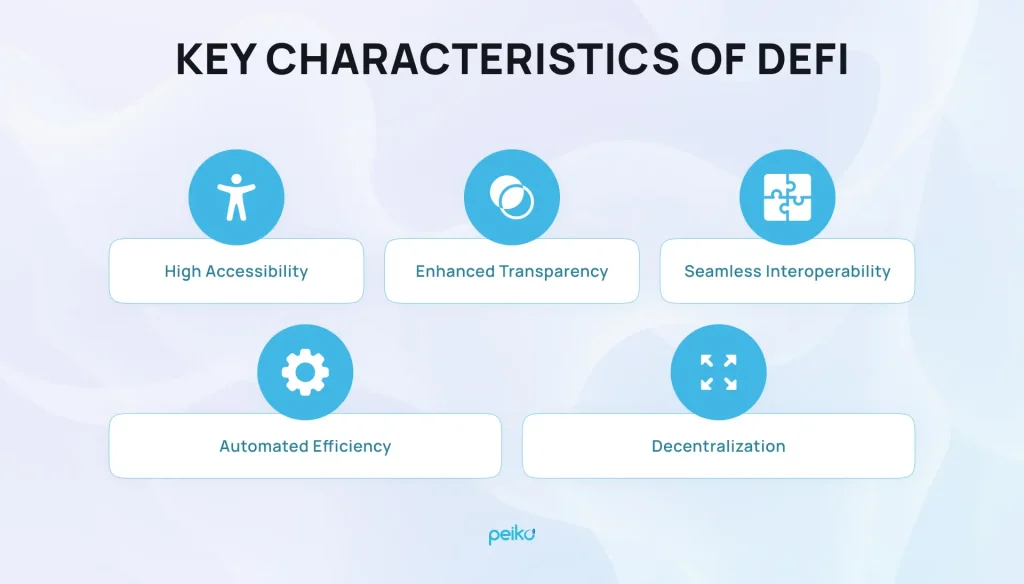
High accessibility
DeFi’s decentralized nature ensures unparalleled accessibility, enabling global, unrestricted access to financial products and services.
Enhanced transparency
Speaking about the benefits of DeFi, we cannot help but mention transparency. Transactions within DeFi are recorded on public blockchains, ensuring robust transparency and auditability, surpassing the transparency levels seen in CeFi.
Seamless interoperability
DeFi systems are engineered for seamless interoperability with various protocols, facilitating the creation of diverse and integrated financial products and services.
Automated efficiency
DeFi leverages smart contracts for automated transaction execution, enhancing operational efficiency and reducing reliance on intermediaries.
Decentralization
Blockchain platforms operate on decentralized, open-source infrastructure, ensuring security, resilience, and autonomy in financial transactions and operations.
Examples of DeFi
The following examples illustrate the successful crypto projects built on decentralized technologies.
Decentralized exchanges (DEX)
What is the difference between centralized and decentralized exchanges?
A DEX is a cryptocurrency trading platform that operates without a central authority, enabling users to trade directly with one another using smart contracts or decentralized protocols.
DEXs give users control over assets, so they are the sole owners of assets. But at the same time, they are less convenient to use and require the payment of many crypto commissions. However, these exchanges are more vulnerable to hacker attacks.
Here are some prominent examples of DEX:
- Augur: This decentralized predictions market doubles as a peer-to-peer exchange, offering unlimited sports betting opportunities. Augur allows users to track diverse sports events and global markets, leveraging cryptocurrencies for predictions.
- Kyber: Operating as a decentralized exchange, Kyber supports multi-chain cryptocurrency trading, enabling users to monitor and secure the best token rates through efficient swap functionalities.
- Uniswap: A popular decentralized exchange that simplifies automated token swaps on the Ethereum blockchain. It uses liquidity pools rather than traditional order books, enabling efficient and decentralized trading.
- Aave: A decentralized lending and borrowing platform that supports many cryptocurrencies. It utilizes innovative features like flash loans, enabling users to borrow assets without collateral if the loan is paid off within the same transaction.
Centralized exchanges (CEX)
A CEX is a traditional cryptocurrency exchange that operates under the control of a central entity or company. It acts as an intermediary between buyers and sellers, providing a centralized platform for trading various cryptocurrencies.
They are more convenient to use and cheaper due to optimization. Also, large exchanges are much safer and more secure. At the same time, users have to work according to the rules and laws of the exchange and can simply be blocked (the FTX collapse).
Here are some examples of popular crypto exchanges in the CeFi blockchain sector.
- Coinbase: A notable CeFi crypto platform, Coinbase offers centralized services for buying, selling, storing, and trading digital assets like Bitcoin and Ethereum. It provides users with wallets and operates under regulatory guidelines.
- Kraken: Operating as a centralized cryptocurrency exchange, Kraken facilitates trading in various digital assets. This CeFi platform offers features such as margin trading, futures trading, and staking services, all managed centrally to ensure security and regulatory compliance.
- Binance: Known globally as a major cryptocurrency exchange, Binance provides CeFi crypto services, including trading, staking, lending, and borrowing of digital assets. It operates under a centralized model with a strong emphasis on security and user experience.
On our blog, you’ll find an in-depth article where we analyze and contrast CEX and DEX platforms.
Surely, there are many blockchain solutions, not only exchanges. These are crypto wallets, dApps, and many others. At Peiko, we are proud of our vast portfolio of successful blockchain and software projects like Zoobdoo, Quan2um, IGT-crypto, and many others.
Drawbacks of DeFi
Decentralized finance is often hailed as the future of financial institutions, yet there are significant drawbacks to consider:
- Complexity: Implementing decentralized technologies and smart contracts can introduce complexities to DeFi services.
- Regulatory uncertainty: Operating outside traditional financial regulations poses risks for users and challenges for regulators aiming to safeguard consumers.
- Volatility: DeFi assets are highly volatile, complicating investment predictions and platform stability.
- Security vulnerabilities: DeFi’s decentralized nature exposes it to increased security risks, including hacking and other threats (if developers haven’t dedicated enough time to security).
- Lack of insurance: Many DeFi protocols lack insurance coverage, leaving users vulnerable to losses from smart contract bugs, hacking incidents, or other unforeseen issues.
The future of DeFi and CeFi
Here are some potential scenarios for how these two forces could evolve:
Evolution of DeFi
Decentralized finance continues to transform the financial landscape by providing transparency, accessibility, and cutting-edge financial products without the participation of intermediaries. Many emerging trends in DeFi are expected to gain recognition, such as DePIN.
As DeFi technology matures, we anticipate broader adoption and improvements in usability, scalability, and security. Enhanced interoperability among different DeFi protocols and blockchain ecosystems is expected to facilitate more integrated and efficient financial services globally. Furthermore, advancements in smart contract capabilities and governance models will bolster the reliability and functionality of DeFi platforms.
Opportunities for DeFi growth
Despite its potential, DeFi faces challenges such as regulatory ambiguity, security vulnerabilities, and scalability limitations. Overcoming these obstacles will be crucial for achieving mainstream acceptance. Regulatory frameworks are likely to evolve to accommodate the unique characteristics of DeFi while ensuring consumer protection and financial stability.
Adaptation in CeFi
The centralized financial system continues to evolve by incorporating blockchain technology to enhance efficiency, reduce costs, and improve user experience. Nowadays, many traditional centralized institutions are exploring and adopting decentralized technologies:
- JPMorgan Chase’s Quorum: Acquired by ConsenSys, Quorum is built on the Ethereum blockchain and serves various financial applications such as supply chain financing and securities settlement.
- R3’s Corda: Designed specifically for the financial sector, Corda is utilized by major banks and financial institutions for applications like trade finance and digital identity management.
- Fidelity Digital Assets: A unit of Fidelity Investments, Fidelity Digital Assets launched a platform offering institutional investors regulated access to bitcoin and ether through a secure custody solution.
The CeFi sector integrates decentralized elements while upholding regulatory compliance and robust security measures. They are vital in bridging traditional finance with blockchain innovations, offering familiar services and interfaces to a broader audience.
Convergence and coexistence
Looking ahead, DeFi and CeFi are expected to coexist and converge in various capacities. Hybrid models may emerge that combine the strengths of both paradigms, delivering comprehensive financial solutions.
The Peiko team will help

Choose Peiko as an experienced blockchain development company
The Peiko team has vast experience creating diverse blockchain solutions, including crypto wallets, smart contracts, Web3 apps, crypto exchange development services, and more.
One of the projects we are proud of is a non-custodial wallet. The client approached us with the vision of creating a sophisticated multi-currency crypto wallet capable of supporting both EVM and non-EVM blockchain networks.
After reviewing their initial design, we discovered several areas for improvement and undertook the task of refining the UI/UX to enhance both functionality and aesthetics. We managed the entire development process, integrating essential third-party services to create a complete blockchain solution.
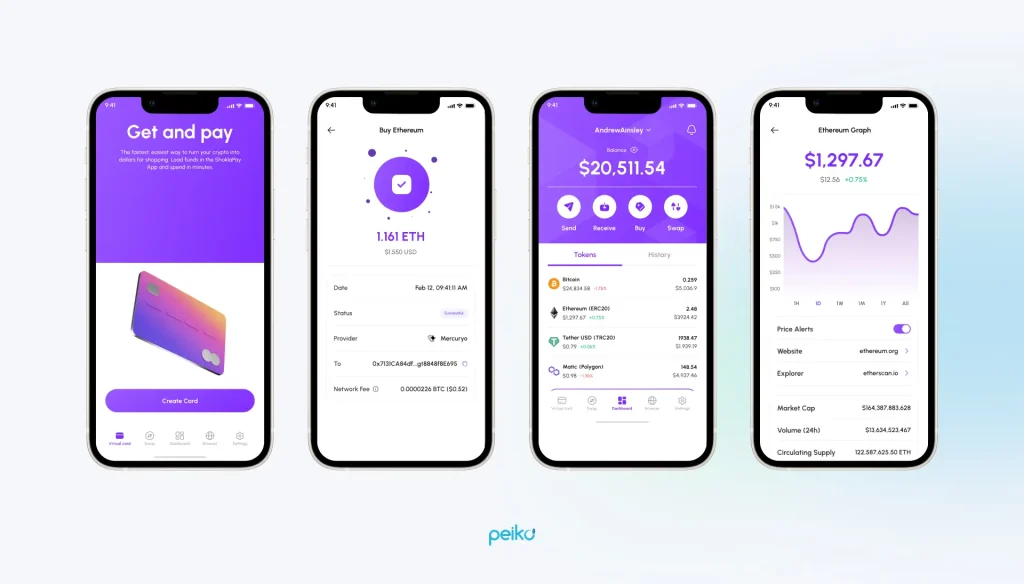
Results achieved
- Multi-chain wallet with seamless support for both EVM and non-EVM networks,
- Cross-chain swap integration for easy cryptocurrency exchanges,
- QR code generator for fast and error-free wallet funding,
- Robust security with KYC, AML, and biometric authentication,
- Redesigned UX/UI for a more intuitive and visually appealing experience.

This project shows our commitment to delivering tailored solutions that enhance functionality, security, and user engagement.
If you are looking for professional fintech app development or blockchain development services, such as DeFi vs CeFi solutions, turn to Peiko. We will conduct a deep business analysis of your idea and assist in implementing it effectively.
Conclusion
In general, CeFi and DeFi embody contrasting paradigms. DeFi’s decentralized structure promotes transparency and innovation via smart contracts, whereas CeFi relies on intermediaries to deliver user-friendly interfaces and adhere to regulatory standards. Their approaches to security also diverge, with DeFi vs CeFi emphasizing user-controlled security measures while CeFi lacks a centralized oversight framework.
These divergent approaches to security and operational structure underscore the ongoing debate between decentralization and centralized control in financial services. As both CeFi DeFi evolve, finding a balance between user autonomy, regulatory compliance, and security will be crucial to shaping the future landscape of global finance.
Looking for custom blockchain development services? The Peiko team can boast a track record of delivering successful blockchain projects across diverse industries that are aligned with different business requirements. If you need a fintech vs DeFi vs any blockchain solution, contact us today to arrange a consultation or request a quote!










